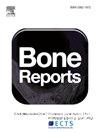荧光胶原杂交肽定量测定骨皮质胶原变性
IF 2.6
Q3 ENDOCRINOLOGY & METABOLISM
引用次数: 0
摘要
临床用骨密度(BMD)评估骨折风险;然而,骨密度正常的个体也会发生骨折,因此需要补充骨折风险评估工具。虽然骨密度仍然是临床的黄金标准,但它未能捕捉到导致脆弱的骨质量因素。其中,胶原蛋白的质量对骨骼韧性至关重要,因为它允许胶原蛋白通过拉伸和展开来消散能量。当胶原蛋白变性时,它失去了变形的能力,增加了骨折的风险。这一过程与衰老、骨质疏松和代谢疾病(如糖尿病)特别相关,但目前还没有临床方法来量化或定位矿化骨中的变性胶原。本研究引入胶原杂交肽(Collagen Hybridizing Peptide, CHP)作为量化皮质骨变性胶原的工具。在这里,我们发现CHP荧光与胶原变性密切相关,通过建立胰蛋白酶-羟脯氨酸测定法(r2 = 0.99),当应用于热处理或机械负荷的矿化组织时。共聚焦显微镜显示当组织应变超过屈服点时,胶原变性增加55% (p <;0.05)。我们的研究结果表明,荧光CHP将骨折表面的高应变区域定位为胶原变性,表明胶原损伤发生在屈服后失效期间。这种非破坏性的技术为评估胶原质提供了强有力的工具,在骨质疏松症、糖尿病骨脆性和衰老研究中具有潜在的应用前景。通过提高我们评估皮质骨骨质量的能力,R-CHP为研究变性胶原如何影响骨抗骨折性提供了新的方法。本文章由计算机程序翻译,如有差异,请以英文原文为准。
Fluorescent collagen hybridizing peptide for quantifying collagen denaturation in cortical bone
Bone fracture risk is clinically assessed with bone mineral density (BMD); however, individuals with normal BMD also experience fractures, highlighting the need for complementary fracture risk assessment tools. While BMD remains the clinical gold standard, it fails to capture bone quality factors that contribute to fragility. Among these, collagen quality is essential for bone toughness, as it allows collagen to dissipate energy via stretching and uncoiling. When collagen is denatured, it loses its ability to deform, increasing fracture risk. This process is particularly relevant in aging, osteoporosis, and metabolic conditions such as diabetes, yet no clinical methods exist to quantify or localize denatured collagen in mineralized bone. This study introduces Collagen Hybridizing Peptide (CHP) as a tool to quantify denatured collagen in cortical bone. Here, we show that CHP fluorescence correlates strongly with collagen denaturation measured by established trypsin-hydroxyproline assay (r2 = 0.99) when applied to mineralized tissue subjected to heat treatment or mechanical loading. Confocal microscopy revealed a 55 % increase in collagen denaturation when tissue strain exceeded the yield point (p < 0.05). Our findings demonstrate that fluorescent CHP localizes high-strain regions to collagen denaturation on bone fracture surfaces, indicating that collagen damage occurs during post-yield failure. This non-destructive technique offers a powerful tool for assessing collagen quality, with potential applications in osteoporosis, diabetic bone fragility, and aging research. By advancing our ability to evaluate bone quality in cortical bone, R-CHP provides new method to study how denatures collagen affects bone resistance to fracture.
求助全文
通过发布文献求助,成功后即可免费获取论文全文。
去求助
来源期刊

Bone Reports
Medicine-Orthopedics and Sports Medicine
CiteScore
4.30
自引率
4.00%
发文量
444
审稿时长
57 days
期刊介绍:
Bone Reports is an interdisciplinary forum for the rapid publication of Original Research Articles and Case Reports across basic, translational and clinical aspects of bone and mineral metabolism. The journal publishes papers that are scientifically sound, with the peer review process focused principally on verifying sound methodologies, and correct data analysis and interpretation. We welcome studies either replicating or failing to replicate a previous study, and null findings. We fulfil a critical and current need to enhance research by publishing reproducibility studies and null findings.
 求助内容:
求助内容: 应助结果提醒方式:
应助结果提醒方式:


